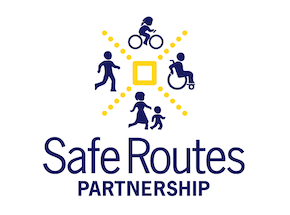FY 2025 SS4A Supporting Materials
At a glance
There is $1 billion available for communities to develop plans and implement strategies to improve roadway safety. Applications are as short as 2 pages, and chances of success are very high. The deadline is June 26, 2025. The Safe Routes Partnership is here to help you win this funding. PLUS - we are hosting a FREE webinar on April 8, 2025. Register now!
The USDOT just released the application for $1 billion in federal funding to plan for and build safe streets through the Safe Streets and Roads for All (SS4A) program. At the Safe Routes Partnership, we are holding a free webinar on Tuesday, April 8, 2025, at 1 p.m. ET to walk folks through the opportunity and how to apply. Register here.
Is your community interested in...
Preventing death and serious injury on roads and streets for all roadway users, including people walking and bicycling?
Understanding where and why people don’t feel safe traveling throughout your community?
Implementing Safe Routes to School strategies to address youth mobility and evaluating the impact?
Building safe, supportive infrastructure that keeps all road users safe?
If you answered “yes” to any of these questions, SS4A is for you!
SS4A Quick Facts
SS4A is a funding program to support communities to achieve zero roadway fatalities through developing safety action plans and building safer roads.
Cities, towns, tribes, metropolitan planning organizations, and other political subdivisions of the state.
Implementation: building projects in existing safety action plans to improve roadway safety.
Planning: developing safety action plans that are multimodal and cover a broad geographic area; developing supplemental plans like Safe Routes to School action plans; demonstration projects of either quick build infrastructure or behavioral interventions, like Walking School Buses.
This is one of the simplest applications for federal funding, with a 2-page maximum narrative for planning projects under $1 million.
Very high. The first 2 years, every eligible applicant with a complete submission was awarded funding. Over 1,400 communities have received this funding, including nearly 700 small, rural communities.
Billings, Montana: awarded $4.4 million to implement safety countermeasures at 11 intersections and 6 corridors in support of a Safe Routes to School initiative.
Carson City, Nevada: awarded $125,000 to update the City’s Safe Routes to School Master Plan to gather the latest available safety data and update the plans' project list.
Salt Lake City Corporation, Utah: awarded $1.2 million to partner with the Children's Media Workshop nonprofit to pilot an interactive safety education program in schools.
There are hundreds of examples of projects focused not only on kids, but on people of all ages and travel modes!
If you want to get into the weeds and learn about what’s different from last year...
Interested in what is new, different, or the focus for this year?
- Logistics
- There is only one deadline, and the clock has already started! This round, there are only 90 days to apply, and all applications must be in by 5 PM ET June 26, 2025.
- There is a lower maximum award for planning and demonstration grants ($5 million, down from $10 million)
- Prioritization
- Justice40 and Biden Administration priorities are gone. Secretary Duffy’s memo on prioritization, including supporting daily transportation needs for families and positive economic return on investment applies to this program.
- The prioritization for communities with fatality rates of 17.5/100,000 remains, and communities that have not received SS4A funds are also prioritized.
- Areas of Persistent Poverty are prioritized for funding. This measures places that have had consistently high rates of people living below the poverty rate.
- Eligibility
- For plan certification, communities can use up to three plans to meet Action Plan requirements in order to apply for implementation, supplemental, or demonstration grants.
- Communities without their own certified action plans can apply for implementation funding if a geography that encompasses them has a certified action plan with projects/strategies identified in the lower jurisdiction. (i.e. a town within a county with a certified action plan)
- Bonus tips
- There is a strong emphasis on ensuring supplemental and demonstration projects inform development of or updates to action plans.
- Demonstration projects are required to be “finite trial periods”, which is a change from prior years.
- There are now only seven components to certified action plans, down from eight under Biden (equity was removed).
- For implementation grants, NEPA and pre-construction design costs can count toward match if you state that in your application.
- There is a strong emphasis on ensuring coordination between entities in the same geography/region (i.e. if a city within an MPO area that has a regional action plan wants to develop a supplemental plan, the applicant must clearly state how they will coordinate with the MPO’s regional action plan).
- This is a critical opportunity to make your streets safer for kids and families.
There is only one window to apply this year, and as the Safe Routes to School field, we can’t afford to miss it!

